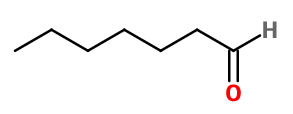
Photo credits: ScenTree SAS
| Company | Ingredient Name | ID | Comments | Naturality | Certifications | MOQ | Purity |
|---|---|---|---|---|---|---|---|
|
|
C07 HEPTYL ALDEHYDE | - |
Learn more
|
- | 10 grs | - |
General Presentation
-
CAS N° :
111-71-7 -
EINECS number :
203-898-4 -
FEMA number :
2540 -
FLAVIS number :
05.031
-
JECFA number :
95 -
Volatility :
Head -
Price Range :
€€€
Physico-chemical properties
-
Appearance :
Colorless liquid -
Density :
0,817 -
Refractive Index @20°C :
1.412 - 1.420 -
Optical rotation :
Data not available. -
Vapor pressure :
3.8 mmHg @20°C 5.0 mmHg @25°C -
Flash Point :
35°C (95°F)
-
Molecular formula :
C7H14O -
Molecular Weight :
114,18 g/mol -
Log P :
2,8 -
Fusion Point :
-43°C (-45,4°F) -
Boiling Point :
153°C (307,4°F) -
Detection Threshold :
3 à 60 ppb (0,000006%) selon les personnes
Chemistry & Uses
Uses in perfumery :
Aldehyde C-7 is used in marine, floral, tea, melon, mimosa, hyacinth and citrus notes. Can bring a plastic effect if overdosed.
Year of discovery :
Data not available.
Natural availability :
Aldehyde C-7 can be found in its natural state, especially in Champaca Absolute, Narcissus Absolute or Damask Rose Absolute (and other roses), from which it can be extracted by fractional distillation.
Isomerism :
Isoamyl acetate and Methyl Amyl Ketone are constitutional isomers of Aldehyde C-7, but have a very different smell: more fruity for Isoamyl acetate and more mushroom for Methyl Amyl Ketone.
Synthesis precursor :
Aldehyde C-7 enters the first stage of synthesis of Neofolione®, in combination with malonic acid. It forms a Schiff base by reaction with Methyl Anthranilate or Indole for example. It can also be used for condensation with another aldehyde or ketone to form the desired alcene.
Synthesis route :
Aldehyde C-7 is an aliphatic aldehyde. Like the other aldehydes, it can be synthesized by reaction of heptyl halides (chloride, for example) and dimethyl sulfoxide (DMSO), followed by an alklaine treatment with sodium bicarbonate. Other synthetic routes exist such as a reduction of Rosenmund from heptylic acid, using an acid chloride.
Stability :
Aldehydes may form diethylacetals in alcoholic perfumes, with no real impact on their smell
Other comments :
In comparision to other aliphatic aldehydes as Aldehyde C-8, Aldehyde C-7 does not have an aldehydic facet and is much more floral.
Anosmy is current regarding this molecule
IFRA
IFRA 51th :
This ingredient is not restricted for the 51th amendment

